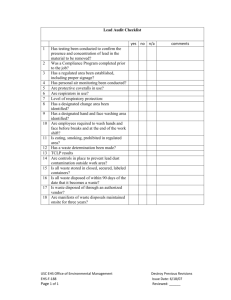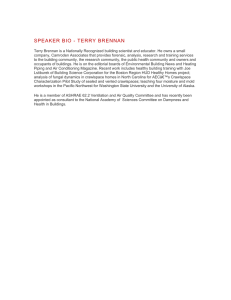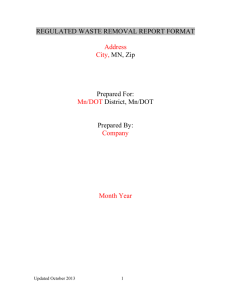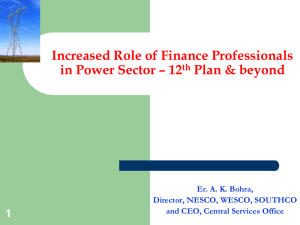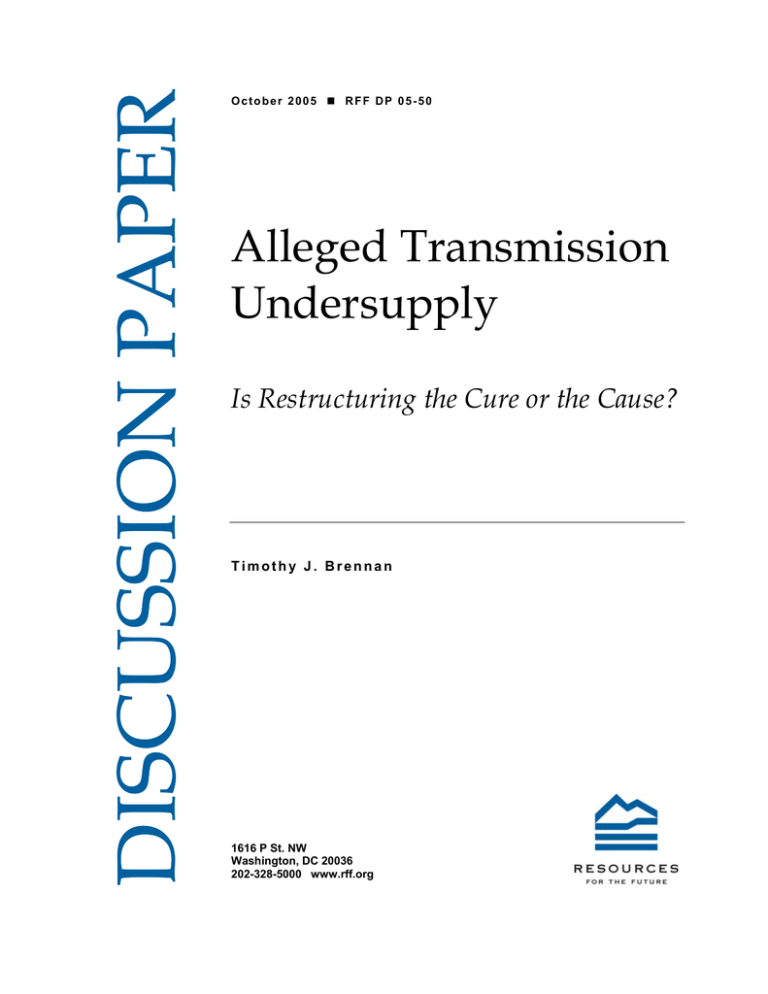
DISCUSSION PAPER
October 2005 RFF DP 05-50
Alleged Transmission
Undersupply
Is Restructuring the Cure or the Cause?
Timothy J. Brennan
1616 P St. NW
Washington, DC 20036
202-328-5000 www.rff.org
Alleged Transmission Undersupply: Is Restructuring the Cure
or the Cause?
Timothy J. Brennan
Abstract
Widespread concern over transmission capacity requires theoretical support to infer inadequacy
from observed trends indicating reductions in the ratio of transmission to generation capacity over time.
If integrated utilities had been regulated with allowed returns exceeding capital costs, transmissiongeneration ratios would have been excessive, and observed trends might be a correction. However,
numerous commentators claim that post-restructuring transmission rates have been too low, with NIMBY
also discouraging investment. We model the possibility that inadequate separation between generation
and transmission may result in reduced investment, in order to preserve incumbent market power in
generation. However, consideration of transmission price caps and coordinated generation investment
support other analyses that conclude that vertical separation itself may be a culprit.
Key Words: electricity transmission, regulation, deregulation, vertical integration
JEL Classification Numbers: L94, L51, L22
© 2005 Resources for the Future. All rights reserved. No portion of this paper may be reproduced without
permission of the authors.
Discussion papers are research materials circulated by their authors for purposes of information and discussion.
They have not necessarily undergone formal peer review.
Contents
I. Introduction ......................................................................................................................... 1
II. Excessive Transmission Investment as a Regulatory Artifact....................................... 4
III. Postderegulation Regulation ........................................................................................... 7
IV. Insufficient Vertical Separation: Discrimination Against Entrants ............................ 9
V. Insufficient Vertical Integration? Coordinating Lumpy Investments ........................ 13
VI. Conclusion ....................................................................................................................... 17
References.............................................................................................................................. 18
Alleged Transmission Undersupply: Is Restructuring the Cure
or the Cause?
Timothy J. Brennan*
I. Introduction
Many electricity industry observers regard transmission capacity as inadequate (Fox-Penner
2005). Rates of capacity expansion are below growth rates in generation. The U.S. transmission
grids were designed for spatially partitioned monopoly utilities with only occasional trading for
reliability, not for open wholesale markets with significant long-distance wheeling. Rapid
spreading and the persistence of the August 2003 outage in the northeastern United States and
Canada engendered further concern.
A basis for the view that transmission capacity is inadequate is that it has fallen in the last 20
years in absolute amounts and relative to the quantity of energy supplied over the transmission
network. Hirst, using North American Electric Reliability Council (NERC) and Edison Electric
Institute data, finds that, normalized to summer peak loads, transmission capacity has fallen at a
rate of about 1.5 percent per year from a peak in 1982 (Hirst 2004, 7).1 In absolute terms, new
annual transmission investment from investor-owned utilities fell at an inflation-adjusted rate of
$83 million per year from 1975 to 1999, from a peak value in the late 1970s of about $4.5 billion
to about $2.7 billion in the late 1990s.2 Since 1999, however, investment has increased at an
annual rate of $286 million per year (Hirst 2004, 7). Since 1999, this investment appears to have
Timothy J. Brennan is Professor, Public Policy and Economics, University of Maryland, Baltimore County; and
Senior Fellow, Resources for the Future. E-mail the author at brennan@umbc.edu. The author is grateful for
comments from Marisa Ilic, Paul Kleindorfer, Russell Pittman, David Salant, John Small, and participants in the
Rutgers University Center for Research in Regulated Industries 24th Eastern Conference. Errors remain the
responsibility of the author.
1
Based on NERC data on planned transmission expansions, Hirst expects this trend to continue until at least 2012.
See also Fama (2004, 18).
2
Citing another study by Hirst and Kirby, Stagliano and Hayden (2004, 37) report that investment has been
“declining by almost $120 million per year for the past 25 years.”
1
Resources for the Future
Brennan
not reversed the decline of capacity relative to load, though, as also indicated by a sixfold
increase in the number transmission loading relief (TLR) calls from 1998 to 2003 (Hirst 2004,
8).3
Although these findings and episodes suggest a problem, none is dispositive. Optimal
investment in transmission is probably not so high as to render outages impossible. In principle,
there can be too much transmission capacity relative to load. At least with respect to reliability,
transmission investments need not be severely at risk. The North American Electric Reliability
Council (NERC 2004, 3) recently found that “seven of ten [NERC Regions] and all ISO
[independent system operators]/RTOs [regional transmission organizations] have Regional
transmission planning criteria that go beyond NERC standards.” However, NERC has also
suggested that economic considerations may warrant grid expansion beyond that dictated by
reliability concerns (NERC 2002, 7). ICF, in a study for the owner of the International
Transmission Company, found that transmission investment of $8.2 billion could save $12.6
billion in energy costs, with savings up to $18 billion if reserve margins are appropriately
reduced and up to $50 billion if the costs of avoided outages are taken into account.4
Justifying policy intervention requires theoretical reasons why suppliers of transmission
capacity would underinvest.5 Perhaps regulated rates for transmission would not produce
revenues sufficient to cover expansion cost, but ability to pass through costs would suggest that
there might be few limits to expansion. More likely possibilities involve the degree to which
generation companies control expansion. A now-traditional concern, rationalizing the creation of
ISOs and RTOs, is that integrated utilities will limit capacity to deter entry or limit expansion by
3
Hirst offers no explanation of the inconsistency between the increase in investment and the apparent simultaneous
increase in TLR calls.
4
“ICF Study Concludes that $8 Billion Investment in Nation’s Transmission Grid Could Yield $12 Billion in
Savings,” Foster Electric Report (May 26, 2004): 15.
5
We do not attempt to test the underinvestment proposition by estimating whether the marginal benefits from
transmission expansion exceed marginal cost. Hale, Overbye, and Leckey (2000) and Kleit and Reitzes (2004)
empirical estimations of the marginal benefits expanding transmission capacity http://ssrn.com/abstract=645085.
2
Resources for the Future
Brennan
competitors.6 Creating financial transmission rights (FTRs) to hedge against variations in
locational marginal prices may also vest generators (and other FTR holders) with an interest in
limiting capacity to profit from congestion rents.
Unlike some other partially regulated sectors, however, vertical separation may discourage as
well as encourage capital expansion in the regulated side.7 Transmission investment is
notoriously lumpy. The profitability of such investment and its value to the public depend on
coordination with similarly lumpy investments in generation. As some generation will likely
come online after a transmission line is constructed, efficient transmission investment and
competitive generation requires the design and solution of a multistage game among the
transmission provider and generators that can choose to build earlier or later. If such a game
cannot be solved without vertical integration or its equivalent, competition and adequate
investment may not be reconcilable. This observation restates Taylor and Van Doren’s (2004)
contention that because vertical integration may be the most efficient way of organizing the
electricity sector, re-regulation of an integrated industry may be preferable to partial deregulation
if full deregulation is politically infeasible.
The remainder of the paper is organized as follows. Section II offers a model indicating that
excessive transmission investment would be the predictable outcome of earlier regulation if the
allowed rate of return exceeds the costs of capital. Section III surveys claims that inadequate
present returns, methodological uncertainty, and siting delays are responsible for reduced rates of
investment. Section IV provides a simple model of discrimination by partially regulated
vertically integrated firms to support the claim that residual vertical integration in the
restructuring era would discourage transmission expansion. Section V describes two thought
experiments and reviews other arguments suggesting that strict separation is ineffective and
impedes the coordination necessary for appropriate transmission and generation investment.
Section VI concludes.
6
Federal Energy Regulatory Commission (FERC) 1996, 1999.
7
Pittman (2005) analyzes similar concerns regarding vertical coordination in rail.
3
Resources for the Future
Brennan
II. Excessive Transmission Investment as a Regulatory Artifact
A declining ratio of transmission capacity to generation capacity could indicate overbuilding
prior to opening wholesale markets. Under cost-of-service regulation, utilities would have no
direct incentive to limit transmission costs beyond that provided by regulatory oversight of the
prudence of those investments. Moreover, to the extent that the political cost of an outage
exceeds the political cost of higher electricity costs, utilities and their regulators will each have
an incentive to overinsure against blackout risk by encouraging excess transmission capacity.
A second factor that could lead to excessive investment during the regulatory era would be
the Averch-Johnson effect (Averch and Johnson 1962). Suppose that during the 1970s, prior to
the period in the Hirst data, electric utilities received an excessive rate of return. As is well
known, they would bias their inputs toward a greater capital/labor ratio than would be optimal
(Baumol and Klevoric 1970). One would expect that if transmission is more capital intensive
than generation, this would lead utilities to bias their technological choices toward transmission,
i.e., to have a greater transmission/generation ratio than would be optimal.
A derivation of the technological choice with and without regulatory constraint suggests such
a bias. Let the output Q of a utility be given by
Q(K, L) = F(G(K, L), T(K, L)),
where G and T refer, respectively, to generation and transmission, and K and L refer,
respectively, to capital and labor.8 We can interpret this function as implicitly representing how
the regulated firm would allocate a total of K units of capital and L units of labor to produce G
units of generation and T units of transmission, in turn to produce Q units of electricity. If R is
the rental rate on capital and W is the wage, then the optimal capital/labor ratio satisfies
8
“Labor” refers to any non-capital expense, and “W” to its price.
4
Resources for the Future
Brennan
FG G K + FT TK R
=
.
FG G L + FT TL W
To explain this expression, TK is the increase in transmission that the utility would undertake if it
has an additional unit of capital to allocate toward transmission or generation; and the
expressions GK, TL, and GL are similarly interpreted. Where this is satisfied, the ratio of the
marginal product of transmission to generation will be given by
FT [R/W]G L − G K
=
.
FG
TK − [R/W]TL
Generally, the lower this ratio, the greater will be the ratio of transmission to generation.
If the utility is allowed a rate of return S > R, it will maximize profits
Π(K, L) = [S – R]K + λ[P(Q(K, L))Q(K,L) – WL – SK].
The first term is profit as a function of the capital installed, and the second is the constraint that
revenues (price P(Q) times output Q) equal labor expense plus the allowed return on capital.
Because profit increases as S increases, we have that λ < 1; because profit falls as W increases,
we have that λ > 0.
The two first-order conditions for a profit maximum will be
ΠK = 0: S – R + λ[[P’Q + P][FGGK + FTTK] – S] = 0
ΠL = 0: λ[[P’Q + P][FGGL + FTTL] – W] = 0.
Assuming that the constraint binds, we can use the labor first-order condition to substitute for
marginal revenue in the capital first-order condition and rearrange terms to obtain
5
Resources for the Future
Brennan
FG G K + FT TK
S S-R
=
−
.
FG G L + FT TL W λW
Let Z be the expression on the right hand of the equal sign. If λ = 1, Z = R/W, as in the
unconstrained case.9 As λ decreases toward 0, the subtracted term becomes larger; hence Z
decreases.
As in the unconstrained case, one can solve this expression for the ratio of the marginal
products of transmission to generation
FT ZG L − G K
=
.
FG
TK − ZTL
If TK/GK > TL/GL, then FT/FG falls as Z falls. Because Z is less than R/W, we have that if the firm
is allowed to earn an excessive return, the ratio of the marginal product of transmission to
generation is less than that in the unconstrained case. The expression
TK
T
> L
GK GL
states that an extra unit of capital has a greater effect than does an extra unit of labor on installed
transmission relative to generation. It is in this sense that transmission is defined as more capital
intensive than generation. Consequently, when transmission is relatively more capital intensive
than generation in this sense, the regulated firm chooses a ratio of transmission to generation
greater than in the unconstrained case.10
9 λ takes a value of 1 in the unconstrained case because we, in effect, incorporated the constraint in defining profit as
[S – R]K.
10 If S is sufficiently large, the constraint will be nonbinding, with λ = 1, and there will be no distortion; see note 9
above.
6
Resources for the Future
Brennan
Although it is not definitive, this analysis suggests that transmission might have been
overbuilt relative to generation during the cost-of-service era. The decline in the transmission-togeneration ratio beginning in the early 1980s could be consistent with this finding. During the
early 1980s, inflation rates were at unprecedented levels. Experience with a rate case at the time
suggests that regulators would have had to allow unprecedented high rates of returns to keep real
returns constant.11 If real returns fell below the real cost of capital, the utility sector afterward
would no longer have had the incentive to overuse capital relative to other inputs in general, and
to overbuild transmission relative to generation in particular.
III. Postderegulation Regulation
Following the Public Utility Regulatory Policies Act (PURPA) in 1978, the Energy Policy Act
(EPAct) in 1992, and FERC’s Orders 888 and 889 in 1996, the electricity sector has moved
toward a situation where, in much of the county, wholesale generation is deregulated while
transmission remains regulated. As we saw above, continued regulation of transmission in and of
itself could lead to overinvestment. However, perhaps courts are unlikely to be able to hold
regulators to the legal standard that “the return to the equity owner should be commensurate with
returns on investments in other enterprises having corresponding risks. That return, moreover,
should be sufficient to assure confidence in the financial integrity of the enterprise, so as to
maintain its credit and to attract capital.”12 Absent enforcement of this standard, rates need not be
above the cost of capital, at least in the short to medium term, once investments are sunk in
place.
Some commentators argue that present returns are inadequate to induce appropriate
investment (Fama 2004). NERC reports that “some entities responsible for the reliability of the
interconnected systems are concerned about the timely recovery of transmission investment at a
11 In the late 1970s through the early 1980s, I was the staff economist on the Antitrust Division’s group litigating the
rates for the Trans-Alaska Oil Pipeline. The need for unprecedented nominal rates of return led to the consideration
of alternative measures of providing returns, e.g., allowing firms to earn a real rate of return on a rate base that was
allowed to increase with the rate of inflation (Brennan 1991).
12 Federal Power Commission v. Hope Natural Gas 320 U.S. 591 (1944).
7
Resources for the Future
Brennan
fair rate of return” (NERC 2002, 9). The Federal Energy Regulatory Commission has proposed
increasing the return on equity for any new transmission facility investments undertaken by an
RTO by 1 percent.13 Absent a finding that transmission investments are more expensive for an
RTO than for traditionally structured utilities, this suggests either that the proposed returns on
RTO investment would be excessive (leading to excessive transmission, for reasons outlined in
the previous section) or that returns on non-RTO transmission investments are inadequate.
The potential for returns to be inadequate would be greater during a restructuring transition,
when methods on how to determine appropriate rates of return and recover costs remain
uncertain. Davis quotes industry experts to the effect that uncertainty about responsibility for
upgrades, cost recovery (including allowed returns and depreciation), reliability standards, and
siting authority discourage investments (Davis 2005; Fox-Penner 2005, 34–36). Methods of
charging for transmission, e.g., postage-stamp or distance-based methods; nodal or zonal pricing;
and claims on congestion rents, present issues that may be unresolved (Trebilcock and Hrab
2004; Brennan, Palmer, and Martinez 2002, chap. 9). Finding that “the U.S. transmission system
is in urgent need of modernization,” the U.S. Department of Energy (2002, xi, xii, 76) concludes
that the incomplete transition to competitive wholesale markets created regulatory uncertainty,
and that “innovative methods for recovering the costs of new transmission-related investments”
still need to be encouraged.
Siting authority that is cited by Davis has two aspects that may discourage investment. One is
the simple “NIMBY” effect, the undesirability of having transmission towers near one’s home or
workplace.14 These effects need not be more intense now than when there was a relative boom in
transmission investment 20–25 years ago. Greater exurban population growth and the use of the
13
Federal Energy Regulatory Commission. 2003. “Proposed Pricing Policy for Efficient Operation and Expansion
of Transmission Grid,” Docket No. PL03-1-000 (January 15), 2.
14
This is not just a problem in the United States. New Zealand is facing a controversy about how or whether to
build a transmission line from the south to deliver additional power to Auckland, its largest city. Landowners south
of Auckland are resisting the efforts of TransPower, New Zealand’s transmission company, to build this line.
Compare the Green Party of New Zealand’s views
(http://www.greens.org.nz/campaigns/energy/transmissionlines.asp, accessed April 3, 2005) with those of
TransPower’s chief executive Ralph Craven (2004).
8
Resources for the Future
Brennan
least-cost rights-of-way might be increasing those costs over time. However, those costs are not
inherently illegitimate: They need to be factored appropriately into the overall test of whether a
particular transmission investment is economically justified.
The second issue regarding siting is that the benefits to having a transmission line in one state
are likely to fall across other states with transmission lines on the same grid. Expanding capacity
in one state not only increases direct deliveries into neighboring states, but, because of loop flow,
it may also have indirect effects in increasing transmission capacity over lines in other states. (It
may reduce capacity of some lines, as well.) As long as decisions rest with individual states or
utilities on a larger regional grid, transmission expansion will be short of the optimum unless
those undertaking the construction are able to capture the benefits of that expansion.15 This is the
primary reason why RTOs should be regional, crossing state and perhaps national boundaries
(Brennan 2003). Legal and political uncertainty in the relations between state regulators, utilities,
and RTOs will only exacerbate reluctance to invest.
IV. Insufficient Vertical Separation: Discrimination Against Entrants
One might regard the above impediments as arising from imperfections in the regulatory
implementation of restructuring. A second set of problems arises from the implementation of the
restructuring itself. In particular, restructuring may not have successfully broken the bonds
between the regulated transmission sector and the unregulated generation sector. That such
bonds create difficulties is well known. A regulated monopolist operating also in an upstream or
downstream market has an incentive to discriminate against its competitors in the vertically
related market by delaying or denying access to the regulated service. In effect, this creates a tie
that allows the regulated firm to extract profits from its monopoly that the regulation otherwise
prevents (Brennan 1987a).16
15
The competitive benefits of even a small increment to the transmission grid may be substantial (Borenstein,
Bushnell, and Stoft 2000).
16
This argument shows that regulation creates incentives to act anticompetitively, and thus that antitrust
enforcement is particularly warranted in partially regulated sectors. A recent U.S. Supreme Court decision takes the
opposite view (Verizon v. Trinko, 540 U.S. 398, 411–15 [2004]).
9
Resources for the Future
Brennan
One can illustrate the effects with a simple model. Suppose a regulated service (e.g.,
transmission capacity) is used in fixed one-to-one proportions with an unregulated downstream
good (electric energy). The regulated firm operates in both markets. Its competitors in the
unregulated market obtain the regulated good at regulated price R.17 The minimum average cost
of providing the unregulated product by those competitors is M. Assuming perfectly elastic
supply by the competitors absent any discrimination by the regulated firm, the downstream price
would be M + R.18 However, we assume that the regulated firm can increase its competitors’ cost
M by T, through discriminatory access policies. Hence, the downstream price will be M + R + T.
The quantity sold in the downstream market is given by demand D(M + R + T); D' < 0. The
regulated firm can choose to sell X in the downstream market, leaving D(M + R + T) – X of the
downstream market for the competitors. If so, it obtains R[D(M + R + T) – X] from sales of the
unregulated product.19 T is discriminatory in that it affects the costs of the competitors but does
not represent a higher price for the regulated service than the price that the regulated firm could
take in directly. The regulated firm’s costs specific to serving the unregulated market are H(X);
its costs of providing the regulated product will be C(D(M + R + T)). Both cost functions have
positive first and second derivatives.
The regulated firm’s profits depend on its choice of X and T. Assume first an internal
solution, that the optimal level of X and T would leave some sales to the unaffiliated downstream
competitors, i.e., that
D(M + R + T) > X.
17
For simplicity, we make the regulated price exogenous (as under a price cap) rather than endogenous (as under
cost-of-service regulation). Brennan (1987b) provides a more complex model with endogenous pricing.
18
Crew, Kleindorfer, and Sumpter (2005) model discrimination using Cournot competition in the downstream
market between the regulated firm and a competitor.
19
We can neglect sales to itself of the regulated product as a purely internal transfer.
10
Resources for the Future
Brennan
The regulated firm’s profits will be given by
Π(X, T) = X[M + R + T] + R[D(M + R + T) – X] – C(D(M + R + T)) – H(X).
The first-order conditions are
ΠX = 0: M + R + T – R – H' = M + T – H' = 0
ΠT = 0: X + [R– C]D' = 0.
The first condition says that if the unaffiliated producers are in the market, the regulated firm
takes the downstream market price as given and produces up to the point where the added
revenue from selling downstream (M + T) equals the marginal cost of selling in the downstream
market (H'). The second condition is that the firm sets the discrimination penalty T on rivals at
the point where the gains from the tax (X, downstream sales) equals the lost profit from sales of
the regulated good to the downstream firms (–[R – C]D').20 On the one hand, and not
surprisingly, the greater the price the regulated firm can already obtain from the regulated
service, the less incentive it has to discriminate against unaffiliated competitors (Weisman
1995).21
On the other hand, if R equals C, or is “close” to it, the regulated firm would have no
incentive not to raise the discrimination penalty to the point where the unaffiliated competitors
would be foreclosed from the downstream market. If so, the downstream market is left entirely to
20
This is consistent with the result that the incentive to discriminate falls the greater the price that can be charged
for the regulated service.
21
Although that part of Weisman’s analysis is correct, regulated firms will still have an incentive to discriminate
against competitors to the detriment of consumer welfare if they are vertically integrated. Reiffen (1998) shows that
Weisman gets a contrary result, in part by assuming that it is less costly to provide high-quality access to unaffiliated
competitors.
11
Resources for the Future
Brennan
it, implying that X = D(M + R + T). With T raised to the point where the unaffiliated firms are
foreclosed, the regulated firm’s profit becomes
Π(X, T) = XQ(X) – C(X) – H(X),
with Q(X) = D-1(X) being the price at which X units are purchased. The first-order condition
becomes
ΠX = 0: Q – C' – H' + XQ' = 0.
Marginal revenue in the downstream market (Q + XQ') is equated to marginal cost (C' + H').
Regulation is evaded completely, with the firm setting the monopoly quantity of X and capturing
all of the profits from its regulated monopoly in the downstream market.22
Prior examples of antitrust concern with vertical integration or controls between regulated
and competitive sectors go back at least to concerns with undersizing of pipelines in order to
reduce downstream supplies or to exercise monopsony power upstream (Brennan 2005, 10–12).
This theory later served as the leading rationale for breaking up AT&T in 1984 and subsequently
keeping the divested regulated local telephone companies out of the long-distance market
(Brennan 1995). In electricity, the desire to discourage discrimination has led regulators to
encourage (but not yet mandate) ISOs and RTOs so that the control of regulated monopoly
transmission networks is nominally out of the hands of utilities that also own generation (Moss
2005, 22–27).
22
Apart from these effects, vertically separated regulated firms may have less incentive to invest in quality than if
they were unregulated; the effect depends on the extent to which consumers respond to quality increases at high
(unregulated) prices compared to lower (regulated) prices and the degree to which downstream markets pass through
lower upstream access charges (Buehler, Schmultzler and Benz, 2004).
12
Resources for the Future
Brennan
Whether this has worked is questionable. RTOs do not provide a complete separation, but
only “functional unbundling” of generation from transmission. One might expect that with
retained generation owners retaining control over transmission grids, RTOs may have incentives
other than maximizing economic welfare. Oren (1997) and Joskow and Tirole (2000) find that
generator claims on higher transmission congestion revenues, in order to hedge against high
transmission prices, can lead to inefficient outcomes. This result is not surprising; ownership of
transmission rights gives generators a greater claim on the extra profits produced by withholding
output.
Even with these limitations and imperfections, Kelly and Moody (2005) note that RTO
formation has “hit the wall,” with only one new RTO formed since FERC’s Order 2000, and
little prospects for more. With this record, it is not surprising that there are some empirical
indicators that transmission capacity may be held back to limit competition. Moss (2004, 22)
finds that the majority of TLR calls, indicating limited transmission capacity, have been made by
“either single system security coordinators … or multiple-system security coordinators
dominated by large, vertically integrated utilities.”
V. Insufficient Vertical Integration? Coordinating Lumpy Investments
The discrimination model and the policy discussion it implicitly motivates suggest that residual
vertical integration is the cause of transmission underinvestment, because incumbent utilities
resist grid expansion that would largely facilitate competition from new entrants. However, the
need to coordinate transmission and generation, both in the short run and the long run, suggest
that a lack of vertical integration could also discourage otherwise warranted expansion. The
central problem is that for partial deregulation to work efficient production and expansion
decisions in the regulated sector need to be made independently of specific adjustments to prices
and supplies in the unregulated sector. If the regulated sector cannot operate efficiently without
the ability to control supplies and investments in the unregulated sector, the latter cannot exploit
the decentralized, entrepreneurial environment that markets can create.
13
Resources for the Future
Brennan
Two related thought experiments illustrate the problem in electricity.
Short run—designing transmission price caps. A hallmark of efficient regulatory design is
the ability to adapt incentive-based regulatory structures, such as price caps. Price caps provide
incentives for regulated firms to control costs, discourage cross-subsidization, and maximize
welfare subject to the profits that the regulated firm may get (Brennan 1989).23 The feasibility of
price caps, however, also provides an illustration of the extent to which the unregulated sector
buying the regulated services at capped prices can operate independently of the caps. In the case
of access to local telephone markets, which was the original application, price caps work because
long-distance companies can add, expand, and purchase relatively small increments at a time.
The long-distance industry could develop efficiently, taking access price caps as given.
Whether transmission price caps can accommodate the huge variations in both the short run
(demand peaks) and long run (large new generators) is less than clear. Price caps can work well
when demand for transmission is stable. When transmission capacity is constrained, however,
efficient dispatch requires nodal prices for transmission to rise as far as necessary to induce
appropriate supply responses to line congestion (Hogan 1992). On the surface, such prices are
incompatible with price caps that set limits on the charges that a transmission line can impose on
its users.24
Long run—the transmission investment game. To consider the long-run problem, imagine
the following game.25 The players are one regulated transmission company and two potential
generation entrants, facing an electricity market with growing demand. The decisions that the
regulator must make is when to have the transmission company install a line capable of
eventually carrying power from both generators, and what prices to set to cover the cost of that
23
The major practical difficulty with price caps is that they require a regulatory commitment not to adjust prices if
the regulated firm’s realized profits become too high or low.
24
Some propose instituting price caps only for cost-recovery purposes. However, the price a generator pays to use a
transmission grid at any time would then be the combination of both the cap and a congestion charge. Thus, the
relevant price to use the monopoly asset would remain effectively unconstrained during congested periods.
25
The following scenario is based on a transmission investment problem facing provincial energy regulators in
Alberta (Brennan, T., and J. Doucet. “More Power Creates Puzzle,” Edmonton Journal (November 23, 2001): F1,
F7.).
14
Resources for the Future
Brennan
generation. The decision that the generation companies must make is when to build. Optimally,
one generation company would build first; as demand grew, the second would later come online.
The regulator’s task is to set prices that would induce efficient timing of entry by the
generators. We do not offer a solution to the game; we suspect that there is no robust, general
solution that takes physical constraints, cost, and demand conditions into account. The thought
experiment is whether there’s a way to solve this game without the regulator or transmission
company knowing at least the specific costs of the generators in such a way to, in effect, take
control of the entry decision through the pricing structure to ensure optimality.
These short-run and long-run thought experiments suggest that the transmission and
generation sectors may not be able to run independently, mediated by a relatively simple and
predictable tariff. Although, to paraphrase Adam Smith, extent of the market may be sufficient to
allow specialization in transmission and generation, the concerns raised originally by Coase
(1937) and later by Williamson (1975) on the virtues of internal, hierarchical control may
dominate. The primary virtue of the market—the ability to function without having to aggregate
and communicate information for planning purposes—may be foregone if the transmission
planner requires such extensive knowledge of the generation sector to operate efficiently (Hayek
1945).26
Vertical coordination between sectors may be more important in electricity than in other
partially deregulated industries (oil, gas, telecommunications). Using data on operating expenses,
Kaserman and Mayo (1991, 499) found that “the costs of vertically disintegrated production [at
the sample mean] are 11.96 percent higher than for vertically integrated production.” They
attribute such economies to the features that make solutions to the above games so difficult—
26
I thank Paul Kleindorfer for suggesting Hayek’s perspective as a way to frame this argument.
15
Resources for the Future
Brennan
high transaction costs, supply and demand uncertainty, small numbers bargaining, and
opportunism from sunk specific investments.27
More recent analyses support a concern with the loss of vertical coordination in the
electricity sector. Kwoka (2002, 2003) has found significant efficiency costs from disintegration.
He notes that coordination by RTOs may be able to restore some of these lost efficiencies, but
that would call into question the ability of the generation sector to act competitively without
control by the monopolist in the middle. Michaels (2004) suggests that markets can supersede
actual or contractual integration between generation and transmission, but that restructuring
rested on an unwarranted assumption that such integration produced no benefits. He surveys 11
econometric studies of vertical integration (including Kaserman and Mayo’s and Kwoka’s)
finding that all but one discovered cost reductions, many of which are both statistically and
empirically significant.
If vertical integration or, equivalently, extensive central coordination of transmission and
generation is necessary for an efficient energy sector, a stand-alone transmission system will
inherently be unable to reap the full benefits from expansion produced for an independent
generation sector. Absent appropriate coordination, then, there may be too little investment in
transmission relative to the ideal. Notably, these concerns about vertical separation in the utility
industry stand apart from other arguments that introducing competition into the sector may
conflict with supplying reliability. As a public good in electricity due to the inability to store
electricity and, because of grid interconnectedness, to restrict blackouts to only those customers
of generators that fail to meet their demand, competitive electricity markets may tend to provide
too little reliability on their own (Brennan, Palmer, and Martinez 2002, 194–97).
27
Uncertainty can delay transmission investment relative to what might seem optimal with certain demand growth,
to preserve the benefits of the option of choosing when to expand (Martzoukos and Teplitz-Sembitzky 1992). Such
delays are, however, consistent with an absence of scope economies between generation and transmission.
16
Resources for the Future
Brennan
VI. Conclusion
A frequently voiced complaint is transmission inadequacy. Data showing a decline in capacity
relative to energy shipments may be an artifact of excessive transmission investment during the
pre-restructuring era. However, as restructuring has developed, uncertainty regarding rates of
return, cost recovery, pricing methods, siting, and interstate externalities may all have
contributed to underinvestment. Most notably, partial deregulation and vertical restructuring may
have discouraged investment. To the extent that vertical separation is not complete, e.g., because
RTOs are not sufficiently widespread or independent, integrated utilities may have the
motivation and means to limit expansion, particular to merchant generators. However, vertical
separation may have led to coordination difficulties that, too, would discourage new transmission
investment.
The hard lesson all of this may be that effective partial deregulation may be chimerical. In
particular, we may be unable to institute independent competition in generation sector, where
each generator takes as given a price of transmission set through an independent process. Early
in the U.S. experience with open wholesale markets, Joskow noted an open question is the design
and degree of vertical control necessary to make restructuring work (Joskow 1997). As noted
above, that open question is whether vertical control necessary to ensure reliability in the
interconnected grid is consistent with such competition. However, the concern over transmission
adequacy suggests that perhaps the sacrifice of vertical economies necessary for wholesale
competition is not worth the benefits. As Taylor and Van Doren (2004) suggest, if transmission
can or should not be deregulated outright, then perhaps the best alternative is to keep both
vertical integration and regulation.
17
Resources for the Future
Brennan
References
Averch, H., and L. Johnson. 1962. “Behavior of the Firm under Regulatory Constraint,”
American Economic Review 52: 1053–69.
Baumol, W., and A. Klevorick. 1970. “Input Choices and Rate-of-Return Regulation: An
Overview of the Discussion,” Bell Journal of Economics and Management Science 1: 162–
90.
Borenstein, S., J. Bushnell, and S. Stoft. 2000. “The Competitive Effects of Transmission
Capacity in a Deregulated Electricity Industry,” RAND Journal of Economics 31: 294–325.
Brennan, T. 1987a. “Understanding the Divestiture in U.S. v AT&T: Why Regulated Firms
Should Be Kept Out of Unregulated Markets,” Antitrust Bulletin 32: 741–93.
Brennan, T. 1987b. “Cross-Subsidization and Discrimination by Regulated Monopolists,”
Economic Analysis Group Discussion Paper 87-2, Antitrust Division, U.S. Dept. of Justice,
Washington, D.C.
Brennan, T. 1989. “Regulating by ‘Capping’ Prices,” Journal of Regulatory Economics 1: 133–
47.
Brennan, T. 1991. “Depreciation, Investor Compensation, and Welfare under Rate-of-Return
Regulation,” Review of Industrial Organization 6: 73–87.
Brennan, T. 1995. “Does the Theory Behind U.S. v. AT&T Still Apply today?” Antitrust Bulletin
40: 455–82.
Brennan, T. 2003. “State and Federal Roles in Facilitating Retail Electricity Competition,” in
Walls, W. D. (ed.), Regional Transmission Organizations: Restructuring Electricity
Transmission in Canada (Calgary, Alberta: Van Horne Institute), 15–39.
Brennan, T. 2005. “Regulation and Competition as Complements,” in M. Crew and M. Spiegel
(eds.), Obtaining the Best from Regulation and Competition (New York: Kluwer Academic),
1–20.
Brennan, T., K Palmer, and S. Martinez. 2002. Alternating Currents: Electricity Markets and
Public Policy (Washington, D.C.: Resources for the Future).
Buehler, S., A. Schmultzler, and M. Benz. 2004. “Infrastructure Quality in Deregulated
Industries: Is There an Investment Problem?” International Journal of Industrial
Organization 22: 253–68.
Coase, R. 1937. “The Nature of the Firm,” Economica 4: 386–405.
18
Resources for the Future
Brennan
Craven, Ralph. 2004. Grid: TransPower New Zealand Ltd.’s Electricity Industry Newsletter
(October): 2.
Crew, M., P. Kleindorfer, and J. Sumpter. 2005. “Bringing Competition to Telecommunications
by Divesting the RBOCs,” in M. Crew and M. Spiegel (eds.), Obtaining the Best from
Regulation and Competition (New York: Kluwer Academic), 21–40.
Davis, K. 2005. “Uncertainty Keeps Transmission Investment Hideously Gridlocked,” Electric
Light and Power (January/February): 22–23.
Fama, J. 2004. “Financial, Regulatory Fixes Needed to Entice Grid Investment,” Electric Light
and Power (April): 18.
Federal Energy Regulatory Commission. 1996. “Promoting Wholesale Competition Through
Open Access Non-discriminatory Transmission Services by Public Utilities and Recovery of
Stranded Costs by Public Utilities and Transmitting Utilities, Order No. 888, 61 FR 21,540
(May 10).
Federal Energy Regulatory Commission. 1999. “Regional Transmission Organizations, Order
No. 2000,” 89 FERC 61,285 (December 20).
Fox-Penner, P. 2005. “Rethinking the Grid: Avoiding More Blackouts and Modernizing the
Power Grid Will Be Harder than You Think,” Electricity Journal (March): 28–42.
Hale, D., T. Overbye, and T. Leckey. 2000. “Competition Requires Transmission Capacity: The
Case of the U.S. Northeast,” Regulation 23 (Spring): 40–45.
Hayek, F. 1945. “The Uses of Knowledge in Society,” American Economic Review 35: 519–30.
Hirst, E. 2004. U.S. Transmission Capacity: Present Status and Future Prospects. (Washington,
D.C.: Edison Electric Institute).
Hogan, W. 1992. “Contract Networks for Electric Power Transmission,” Journal of Regulatory
Economics 4: 211–42.
Joskow, P. 1997. “Restructuring, Competition, and Regulatory Reform in the Electricity Sector,”
Journal of Economic Perspectives 11: 119–38.
Joskow, P., and J. Tirole. 2000. “Transmission Rights and Market Power on Electric Power
Networks,” RAND Journal of Economics 31: 450–87.
Kaserman, D., and J. Mayo. 1991. “The Measurement of Vertical Economies and the Efficient
Structure of the Electric Utility Industry,” Journal of Industrial Economics 39: 483–502.
Kelly, S., and D. Moody. 2005. “Wholesale Electric Restructuring: Was 2004 the ‘Tipping
Point’?” Electricity Journal (March): 11–18.
19
Resources for the Future
Brennan
Kleit, A., and Reitzes, J. 2004. “Geographic Integration, Transmission Constraints, and
Electricity Restructuring” (November), Social Science Research Network,
http://ssrn.com/abstract=645085.
Kwoka, J. 2002. “Vertical Economies in Electric Power: Evidence on Integration and its
Alternatives,” International Journal of Industrial Organization 20: 653–71.
Kwoka, J. 2003. “Foresight, Hindsight, and Market Power in the Restructured Energy Sector,”
(January 12), American Antitrust Institute, http://www.antitrustinstitute.org/recent2/231c.pdf.
Martzoukos, S., and W. Teplitz-Sembitzky. 1992. “Optimal Timing of Transmission Line
Investments in the Face of Uncertain Demand: An Option Valuation Approach,” Energy
Economics 14: 3–10.
Michaels, R. 2004. “Vertical Integration: The Economics that Electricity Forgot,” Electricity
Journal (December): 11–23).
Moss, D. 2004. “Competition or Reliability in Electricity? What the Coming Policy Shift Means
for Restructuring,” Electricity Journal (March): 11–28.
Moss, D. 2005. “Electricity and Market Power: Current Issues for Restructuring Markets (A
Survey),” AAI Working Paper 05-01, American Antitrust Institute (February),
http://www.antitrustinstitute.org/recent2/381.pdf.
North American Electric Reliability Council. 2002. Transmission Expansion: Issues and
Recommendations (Princeton, NJ: NERC).
North American Electric Reliability Council. 2004. Resource and Transmission Adequacy
Recommendations (Princeton, NJ: NERC).
Oren, S. 1997. “Economic Inefficiency of Passive Transmission Rights in Congested Electricity
Systems with Competitive Generation,” Energy Journal 18: 63–83.
Pittman, R. 2005. “Structural Separation to Create Competition? The Case of Freight Railways,”
Review of Network Economics 4: 181–96.
Reiffen, D. 1998. “A Regulated Firm’s Incentive to Discriminate: A Reevaluation and Extension
of Weisman’s Result,” Journal of Regulatory Economics 14: 79–86.
Stagliano, V., and J. Hayden. 2004. “The Electric Transmission Paradox,” Electricity Journal
(March): 37–46.
Taylor, J., and P. Van Doren. 2004. “Rethinking Electricity Restructuring,” Policy Analysis No.
530, Cato Institute, Washington, D.C. (November 30).
20
Resources for the Future
Brennan
Trebilcock, M., and R. Hrab. 2004. “Electricity Restructuring: A Comparative Review,”
University of Toronto School of Law (March), http://www.lawlib.utoronto.ca/investing/reports/rp41.pdf.
U.S. Department of Energy. 2002. National Transmission Grid Study (Washington, D.C.: U.S
Department of Energy).
Weisman, D. 1995. “Regulation and the Vertically Integrated Firm: The Case of RBOC Entry
into Interlata Long Distance,” Journal of Regulatory Economics 8: 249–66.
Williamson, O. 1975. Markets and Hierarchies: Analysis and Antitrust Implications (New York:
Free Press).
21


